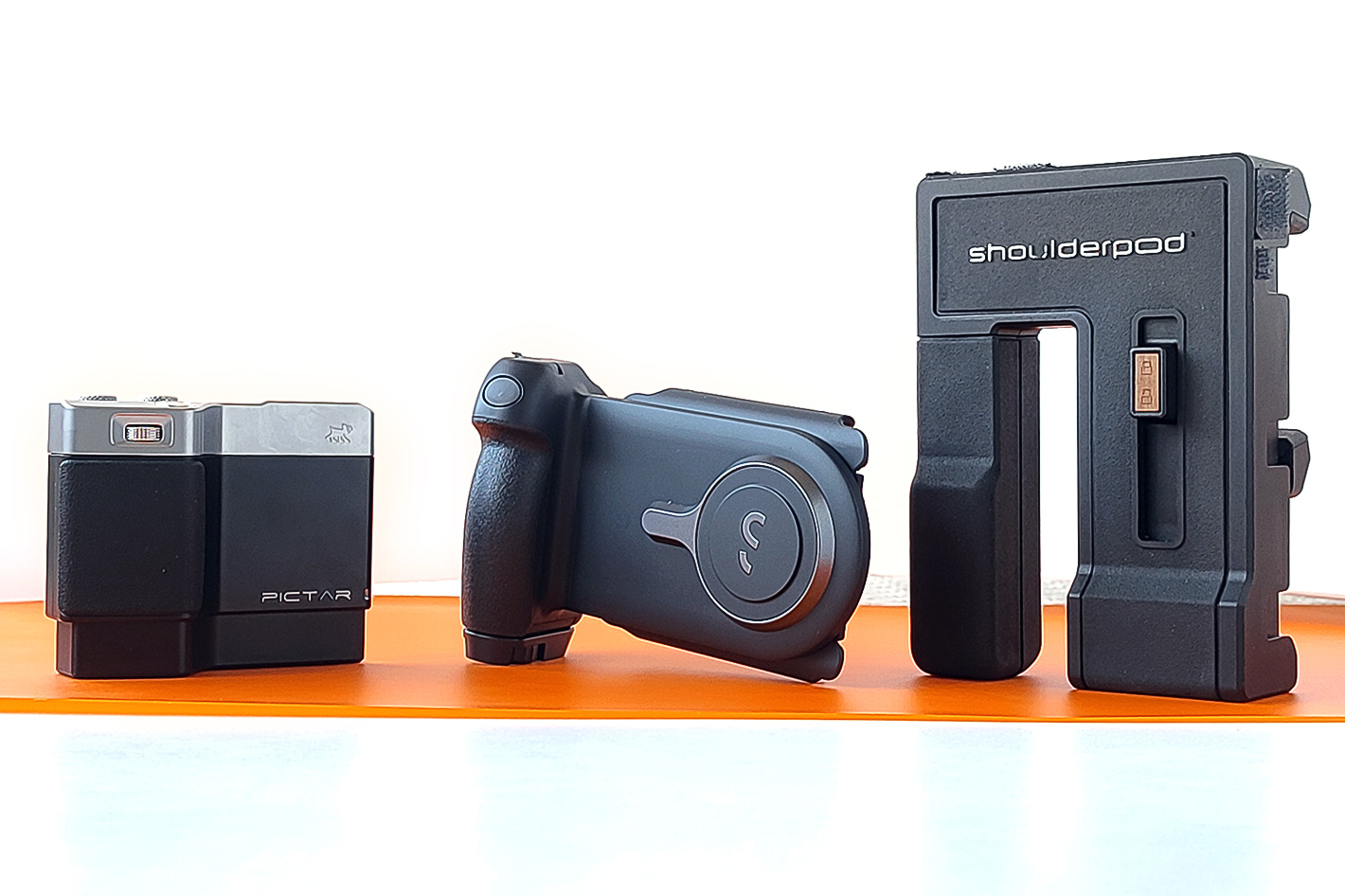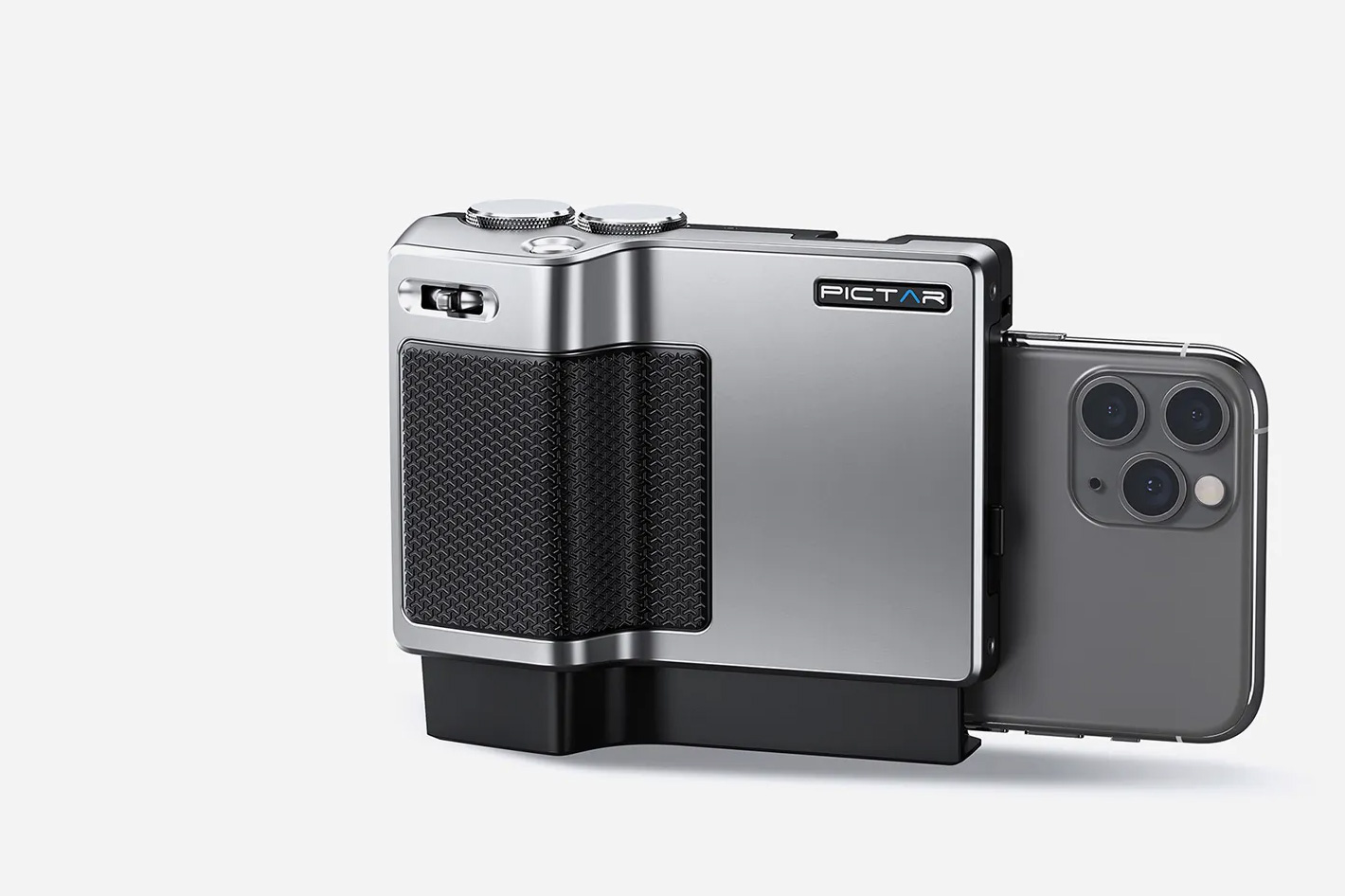
Smartphones are getting better, and many professional photographers and videographers are using them as another tool in their bag. Able to capture, edit and distribute images, stills or video, without the need to use any other device, they are the “best camera you always have with you”… but they fail completely when you grab them to capture images. Even some models that have a shutter button designed to make the operation more like a conventional camera do not offer the same level of steadiness a camera does. And their ergonomics, as photography or video tools, are appalling…
If you want to take your image gathering to a new level, you do need to get some form of support. A smartphone grip is the best way to achieve that goal, if you want a solution that not only supports your smartphone but makes for an experience similar to holding a camera. Yes, there are many pieces of equipment designed to hold smartphones, from selfie sticks and gimbals to supports like the S2 from Shoulderpod. I mention the S2 because I tend to always carry one around, to be ready if I need some form of support. It is a solution I have suggested to other people too, but if you want to do a whole photography or video session, then you need something else.
The smartphone grips here offer an experience similar to that of holding a camera: I’ve picked for this article/review three models I am familiar with: the Pictar One Plus from miggo, the Shoulderpod G2 and the ShiftCam ProGrip. Before I continue, let me say that I also tried a grip, available from Amazon, under different brands, which comes with a shutter button that is removable, making for a great remote shutter using Bluetooth.
While the grip I bought from Amazon looked able to do the job, one of the first times I tried it, with a normal size smartphone the grip claws did not hold the phone in place – I dropped it while shooting on the beach – so I stopped using it. Besides, it would not accept a smartphone with a protective case, which I deem is essential to keep your smartphone safe, so the cheap grip was left in the bin for accessories never used.


Before trying the cheap smartphone grip sold through Amazon I had an experience with a better, promising solution, from miggo, who introduced the Pictar One in 2017. The company also launched the Pictar One Plus and Pro versions in 2018, about which I wrote here at PVC. I noted, then, about the Pictar One Plus, this: “The creators of the product present it as the way to “DSLR your iPhone”. While I do not think the Pictar One transforms my smartphone in a DSLR, it is evident, now that I’ve had the chance to test the Pictar One Plus, that the accessory turns your smartphone in something that feels like a camera you’re holding in your hand. Yes, as miggo also states, the Pictar One “converts your phone into a real camera”. It may be a compact camera, but it surely feels good.”
The problem with the Pictar is the software, at least for Android. It was always faulty, and it has not been updated for a long time, suggesting that the company may have lost interest into the product. I decided to try the Pictar One Plus now with my Samsung Galaxy S22 Ultra and had to give up, and not even the Xiaomi Redmi Note 10 Pro worked. So, this note about the Pictar solution is one of caution: beware if you decide to buy it. It may have been a good solution at launch, but in 2023 is probably best to avoid.
So, now that we’ve put aside the Pictar offerings, it’s time to look at the Shoulderpod G2, which has been my smartphone grip since its introduction. Yes, it’s bulky, yes it does not look very ergonomic, but when you hold it you grow used to that “comfortable brick”, that is both durable and stable, as a support for your smartphone.
Published September 2021, my review “Two years using a Shoulderpod G2 smartphone grip” noted that the company behind the product claimed, at launch – in 2019 – that the G2 was “the most advanced grip for shooting professional video with smartphones” and asked if the claim was still valid two years later. I am glad to be able to write that it is. As I wrote then, “…when it comes to versatility and steadiness, nothing beats the Shoulderpod G2, which some will consider to be to heavy and cumbersome to carry but is exactly what you need if you’re after a versatile video production grip for smartphones with everything included. With dimensions of 155 x 110 x 55 mm and a weight of 417 gr, it’s not a pocket-size solution like the Shoulderpod S2… but it’s not intended to be.”
The review also noted that “designed to hold any mobile device between 65 and 90 mm wide, thanks to an expandable Smart-Clamp mechanism which allows for quick release and smartphone lock, all in one button, the G2 will keep your smartphone precisely in place, thanks to a brake system that increases the friction of the lower clamp making it harder to open. Once you’ve pushed the Smart-Clamp button upwards until you feel a “click,” the smartphone will be safe, even if you move the Shoulderpod G2.
One thing I love about the ShoulderPod G2 is the Smart-Clamp mechanism, which gives me confidence to walk around with the smartphone on the grip without fear of seeing it fall. Besides, it is easy to use, does not feel flimsy or about to break if you push harder. The brick-like design has 6 cold shoes and two tripod mounts, offering a range of options that, as I wrote then, “will make it the only grip you need.”
While apparently not very ergonomic – it was designed with tripod mounting in mind – the ShoulderPod G2 is surprisingly comfortable to use handheld, both in portrait and landscape mode, giving you a “camera-like” grip. The only thing I missed was a shutter release button, and that’s why, with a little DIY, I created a shutter button using a cheap Bluetooth remote shutter typically used with smartphones. I used Velcro to create the contact points at the two places my index finger rests – for vertical and horizontal shots. I wish there was a remote shutter that would fit into the G2’s cold shoes, but this has worked fine so far, with the advantage that this shutter can work on the grip or away from it.
I mention the advantage of a shutter release button that can be moved from the camera body because that’s one of the first things I found was missing from the ShiftCam ProGrip I just bought. Yes, it has a fantastic shutter that works, apparently without glitches, out of the box, but the first thing that occurred to me was: and what if I want to shoot from afar?
Using a real remote shutter is the answer. I’ve tried it and it works. While I’ve written that the Shoulderpod G2 is “the only grip you need”, let me add, now, this: …most of the time. Its sturdiness, versatility and price make it the most affordable – some $70 – accessory of this type available. Having said this, I was curious to try the ShiftCam ProGrip, having read good – and bad – things about it. I mentioned the accessory back in March 2022, but buying one in Europe is not easy, and when recently I found a dealer able to deliver the device in time at a reasonable price – around $170 – I decided it was time to test it.
I am pleased with the ergonomics, which feel way better than the other grips I’ve used (except for my DIY version of the Shoulderpod G2). Although I would like the grip to be larger, as it feels tiny in my hands, I understand that most people will feel comfortable. The shutter release button is well placed and makes it easy to take photos without feeling the whole smartphone moving as you press the button. Once I installed the ProGrip app on my Samsung Galaxy S22 Ultra and activated Bluetooth I could snap away as if holding a real camera.
The ShiftCam ProGrip allows you to rotate your smartphone for portrait photos, and that’s great… I just wish it felt a bit less flimsy in panorama mode, as the whole cradle seems to tend to become slightly slanted. I also worry that with constant use it may become more loose, but I hope to write a new review in some months, sharing my experience with this accessory. Placing the smartphone inside the cradle is also not the easiest operation, and I feel like the plastic claws may break at any moment… something I never felt with the solid solution in the Shoulderpod G2. Also, I do not completely trust that the cradle will keep my smartphone in place when moving, so extra attention must be taken. Again, the Shoulderpod G2 wins, and that’s one of the reasons why I will keep using it when I need more stability and sturdiness.
First impressions about the ShiftCam ProGrip: I like it! The fact that it charges – wirelessly – my Samsung Galaxy S22 Ultra – which just eats battery when photographing, with Bluetooth and everything – is a bonus, although I always carry a power bank with me. Ergonomically it works as intended and will make your photography or video better. The grip itself also works as a charging dock and, thanks to its 75° angle stand is good for video calls and comfortable viewing whilst charging.
When placed upright, the grip also works as a support/tripod for photography and video. In fact, I was quick to adopt it for some tabletop studio photography, as shown in the photos published with this article. It’s stable enough and works both for portrait and landscape, one more good reason to buy the ShiftCam ProGrip. If you’re into table top photography, this and one of those foldable studios (remember Modahaus?) that you can carry anywhere make for a great setup to photograph collections for clients.
Last thing: the ProGrip comes with a nice case that seems ideal to carry the accessory on a waist belt. It works, but I wish ShiftCam had designed it a bit larger, so it would accommodate the smartphone too. A larger one, preferably. While I understand that many people may just use the grip to take a few shots and remove it again, I prefer to keep the smartphone attached to the grip all the time, as my Samsung Galaxy S22 Ultra is more a camera than a smartphone.

